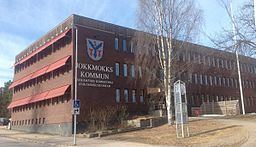ISO 3166 code SE Province Lapland | Time zone CET (UTC+1) Municipal code 2510 | |
 | ||
Points of interest Saltoluokta, Ájtte, Skierfe, Stiftelsen Vuollerim 6000 År, Laponian area | ||
Jokkmokk Municipality (Swedish: Jokkmokks kommun, Finnish: Jokimukan kunta, Northern Sami: Johkamohkki gielda, Meänkieli: Jokinmukka) is a municipality in Norrbotten County in northern Sweden. Its seat is located in Jokkmokk.
Contents
- Map of Jokkmokk Sweden
- History
- Geography
- National parks
- Other attractions
- Getting there
- Localities
- References
Map of Jokkmokk, Sweden
The name Jokkmokk is Sami for the words "river" and "bend", since the town is situated close to a bend in the nearby river. It's Sweden's poorest municipality.
The municipality is the second largest in size of all Swedish municipalities and is, with an area of 19,477 km2 (approximately 7,520 square miles) slightly smaller than Slovenia or the US state of New Jersey. It has never been amalgamated with another entity, having been that large ever since municipalities were established in Sweden in 1863.
History
The name Jokkmokk is present in the Jokkmokk Lapland Court District, a historical jurisdiction. When the municipality was given its current borders in 1971, its municipal coat of arms were made to depict the hydro plant, the symbol of Luleå (to which Jokkmokk belonged until 1673), and the traditional Sami hammers.
Geography
The municipality is situated in the Scandinavian Mountains in Swedish Lapland and is sparsely populated. A large part of the area has been the habitat of reindeer herding Sami people for thousands of years and has for that reason been protected as a UNESCO World Heritage Site under the name Laponian area. The Laponian area is roughly divided into the eastern flatlands and the western mountainous region. There are several well-structured and well-maintained starting locations for those interested in experiencing the majestic wilderness. For instance, the Kvikkjokk basecamp provides excursions and has a high quality hostel.
Due to the northern location, the aurora borealis can be experienced all through winter (November to March), and the midnight sun can be experienced during June and July.
The Lule River and the Lesser Lule River flows through the district. The rivers are heavily regulated for Hydroelectricity, most of all in Sweden. 6 of the 10 largest hydroplants are located in the area. This includes the 977 MW Harsprånget, the 480 MW Porjus and the 460 MW Messaure. There's a total of 11 Hydroplants in the area, 9 over 100 MW, 8 over 200 MW and 4 over 400 MW.
National parks
The four national parks in Jokkmokk Municipality all have their own distinct identity. The national parks are Sarek, Muddus, Padjelanta and Stora Sjöfallet.
These national parks are popular with tourists all year around but the darkest and coldest months (November to January) are not recommended for beginners. The best period for sunshine and winter activities is from February all through April, when the snow lies deep and the days are long. This time of year the national parks are easily accessible by snowmobile and skis. Visitors should understand and respect that the wilderness is just that, and snowmobiles are not allowed in the parks at any time.
The summer in Jokkmokk Municipality is short but intense. The ground is free of snow from May until late October, early November. As with most areas in the Nordic countries, the actual warm period is quite short, but as Jokkmokk Municipality has a continental climate, the temperature can top 30 degrees Celsius in the summer and reach as low as -40 degrees Celsius in the winter. During the summer months hikers and other friends of nature converge in the national parks and this is also the time when most of the parks are most easily accessed. Visitors should be warned that the amount of mosquitoes can be difficult to those not used to them and driving has an added danger in the reindeer that seek shelter from the mosquitoes. Collisions with reindeer are frequent in most of the northern parts of the Nordic countries and drivers should keep an eye out.
Fall is also short and the shifting colors of the wide forests make the surroundings burn with color. This is a good time for hiking but due to the shifting temperatures the mountainous parts of the national parks can be treacherous for those unprepared.
Other attractions
Jokkmokk is known for its Sami market held the first weekend every February. This market has been held for more than 400 consecutive years. Initially a gathering of traders from the entire region the market has long since grown to be more than a simple gathering of traders and is now a week-long cultural event with lectures, art exhibitions, concerts and much more.
Getting there
There are several hotels and hostels in Jokkmokk, Vuollerim and Porjus. Jokkmokk is easily accessed by car and bus from Luleå and Gällivare, where the nearest airports are to be found. Jokkmokk can also be reached by train.
Localities
There are three localities (or urban areas) in Jokkmokk Municipality:
The municipal seat in bold
